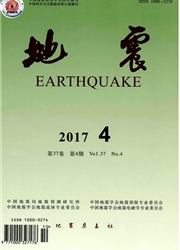

 中文摘要:
中文摘要:
搜集了1900-2013年间发生在中国大陆及其邻区的震源机制解资料,详细整理了其中的70个7级及以上大震的震源参数、地表破裂带和地表位移资料.根据资料的完整程度将地震分成三类:A类存在地表破裂和地表位移观测资料;B类存在地表破裂资料,但缺少地表位移观测数据;C类缺少地表破裂带和地表位移观测资料.对B类和C类缺少地表位移观测数据的地震,利用三角形模型模拟其位移分布.再根据地表位移分布及地震破裂带与本文使用网格模型之间的位置关系将地震分段.最后,利用分段前、后的地震数据和改进的双三次样条方法反演研究区域的形变场模型.结果表明:①大震资料的分段处理改进了地震数据的反演结果,提高了反演模型的合理性和空间一致性;在喜马拉雅断裂带,形变场具有更好的连续性,其变形特征与地质等数据的反演结果基本吻合;塔里木盆地和阿尔金断裂的形变量减小,与该区域较低的地震活动性一致;戈壁—阿尔泰的变形从SE的挤压和NE的拉张调整到NE的挤压和NW的拉张;鄂尔多斯西缘的拉张分量明显减小.②113年的地震资料解释了印度板块向欧亚板块运动总速率的30~50%,存在20 mm/a左右的速度亏损,该亏损量可能包括断层蠕动、褶皱等非震形变,未监测到或者缺失的地震,及以弹性应变能形式存在通过潜在地震释放的应变.
 英文摘要:
英文摘要:
We collected earthquake moment tensors of Chinese mainland and its vicinity in 1900-2013, and gathered source parameters, surface ruptures and displacements of 70 earthquakes with magnitude equal to or greater than 7.0. According to thecolleeteddata, we divided these large earthquakes into three parts. Part A contains earthquakes with surface ruptures and displacements, Part B contains earthquakes without displacements and Part C contains earthquakes without any of these data. We simulated the displacement dis- tribution with the triangular model for Part B and C earthquakes without displacements. Then, we segmented these large earthquakes with displacements and relationship between surface ruptures and grids used in this article. Finally, we determined the deformation model from the segmented and unsegmented earthquake data and modified the bicubic spline function. The results show that 1 The reasonability and spatial consistency of de- formation model are improved with earthquake segmentation, deformation model is more continuity and comparable with geologic and geodetic results in Himalaya thrust fault zones, deformation in the Tarim basin and the Altyn Tagh fault zones are decreased which are comparable with their low seismicity. The directionof compressional deformation in Gobi-Altai is adjusted from SE to NE and its extensional direction is changed from NE to NW. The extensional deformation in the Ordos block is diminished obviously. 2 The earthquakes account for 30--50 percent of expected motion of India relative to Eurasia determined from the geologic data, with the missing component of 20 mm/a, which may con- tain aseismic deformation such as fauh creep and folds, the undetected or missing of earthquake data and elastic strain energy released by potential earthquakes.
 同期刊论文项目
同期刊论文项目
 同项目期刊论文
同项目期刊论文
 期刊信息
期刊信息
